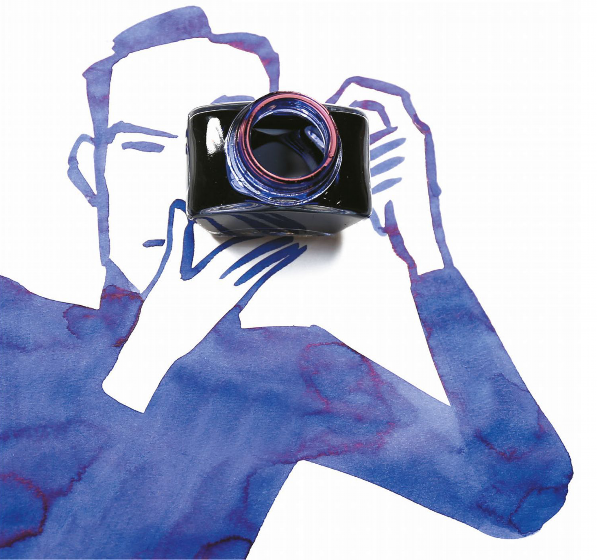10 Creative Truths From Illustrator Christoph Niemann
Christoph Neimann’s self-portrait, as taken from Sunday Sketching. Image: Sunday Sketching.
Illustrator Christoph Neimann’s non-designer friends envy him. “They think it must be fun to sit around all day, doodling away and thinking of funny ideas,” he writes in Abstract City, his visual love letter to working in New York. “I try to tell them it’s quite the opposite and that I often feel that I am spending all day trying to catch chickens with my bare hands.”
That lively visual fits his style—Neimann has drawn live from the Olympic Games in London and has sketched the New York City Marathon, while running it. His work appears regularly in The New Yorker and National Geographic.
In Abstract City, Niemann shares insights into his carefully-structured workday, why writer’s block is a big fat nothingburger, and why yoga is terrible for creativity (because it leads to inner harmony). “As I grow older, I hope to become a more confident and well balanced human being,” he writes. “But as far as my creative work goes, I have realized that self consciousness and tensity are actually professional assets. If I continue to carefully nurture them they will help me sustain a long and prolific career.” Here are 10 of Niemann’s deepest thoughts. Work into your pursuits as you see fit.
“I like coffee so much that I have tea for breakfast. The first cup of the day is so good that I’m afraid I won’t be able to properly appreciate it when I am half-asleep. Therefore I celebrate it two hours later, when I am fully conscious.”
“I go to the studio at 8:45 in the morning. I leave at 5:45 in the evening. In the meantime, I go though what is often referred to as the ‘creative process.’”
“Four hours creative: What exactly happens during those four hours of creative time? This is where the magic happens! No music, no phone calls. I try to focus as hard as I can. But I am a designer, not a machine, and so it does happen that my mind starts to wonder. Sadly, my mind really likes to wander off to the Internet, where I Google myself and check my Amazon sales rank.”
“Two of those four hours for drawing and designing…and another two hours for second-guessing what I just created.”
“I realize I have a finite amount of creative energy and concentration in me. I can’t give you the precise math, but, for conceptual work, I cannnot really go more than four hours in a given twenty-four-hour period. If I push myself to work beyond that threshold, all I produce is garbage.”
“When it comes to drawings or designing on the computer I can go longer, but there is a time when my mind just goes numb. Even worse, if I do try to extend the workday to ten or fourteen or eighteen hours I will be punished with two subpar days after that.”
“I hate it when people tell me, ‘You are so talented.’ The word “talent” implies a natural gift. As if there is a miraculous superpower that helps an artist produce decent work.”
“Some people probably do have an aptitude for drawing or writing, and that makes it easier for them to create, but even this is worthless if you don’t hone your skills through years of practice. If there is any kind of talent I would consider relevant, it would be natural enthusiasm, which keeps you going despite the difficulties and frustrations that are inevitably part of creative work.”
“How do you overcome writer’s block? This makes it sound as though writer’s block is something that (a) you encounter infrequently and for which (b) there is some sort of remedy. Like a skin rash. Trying to overcome writer’s block is exactly what I do from the second I enter my studio to the time I clean up my desk at night. (This is, of course, a figure of speech. I never clean up my desk at night.)”
“A few years ago I had some issues with back pain and I started doing yoga. I would go to Chelsea Piers two or three times a week for a class at lunchtime. Although it worked wonders for my body, it also made me calmer and more relaxed. I started feeling this sense of inner peace and harmony. So I would come back from class, go back to work, and I would look at some drawing I had just done that just wasn’t quite there, and instead of thinking, ‘I have to redo it! Somebody may hate it,’ I was completely calm and thought, ‘It’s not perfect, but aren’t there more important things in life.?’” Be warned: Yoga may make you a happier person, but it will destroy your design career.”
If you’d like to read more from Creative Factor, try the following pieces:

